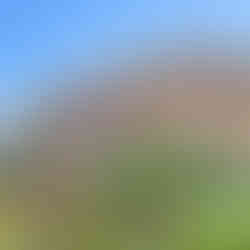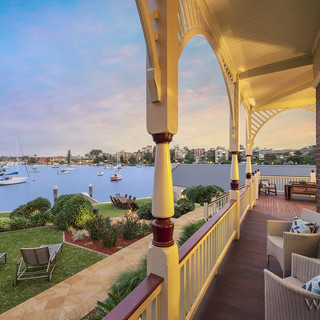Waterfront Drummoyne Federation home the most viewed listing...
- Jon Ruwolt
- Jun 5, 2018
- 6 min read
Updated: Aug 12, 2019
The Charming Federation Housing of Drummoyne NSW
Related pages: Drummoyne Federation, Drummoyne Federation Heritage
"The little known Harris family have listed the imposing Drummoyne riverfront, Clovelly, a substantial, two storey Federation house with $8 million hopes."
"Built of red brick with pebble dash featuring in its chimneys, it was built about 1904 for Stanley Rea, a dentist.
"There have only been two families in ownership since the historic treasure was built with its 22 metre frontage to Drummoyne Bay.
"It goes to June 30 private auction through local agents Warwick Williams and Adrian Sereni." (Property Observer TROPHY HOMES 30 MAY 2018)

Drummoyne sits on the peninsula between Iron Cove and Five Dock Bay. It is surrounded on three sides by Sydney Harbour and the Parramatta River and, as such, has some of Sydney's best waterfront views. Drummoyne neighbours the similarly historic Five Dock and Abbotsford.
Related page: Federation Filigree
Drummoyne was originally part of a land grant to Colonial Surgeon John Harris. In 1841 part of that grant between Thompson and Millar Streets was subdivided and advertised as “40 minutes row from Sydney”.
In 1853, William Wright bought a large chunk of the subdivision and called it “ Drummoyne” after his family home in Scotland.
William Wright was a merchant, whaler and sealer who bought land in the northern part of the area in 1853. The property was bounded by present day Lyons Road and Victoria Road.
Drummoyne House was built in the Georgian Classical style. It was rectangular in plan with a hipped roof with a concave verandah across the entire front and returned along each side.
He named it Drummoyne Park after his family home at Drummoyne on Clyde in Scotland. In Gaelic, Drummoyne means "flat topped ridge".

The city view to the East
The area remained a long row from the city until the 1880’s when construction of the Iron Cove and Gladesville bridges, and the arrival of the tram, caused a boom. Drummoyne’s new ease of access to the city, and its sublime siting by the harbour swiftly made it a desirable address.

Drummoyne is linked to Rozelle by the Victoria Road and Huntleys Point by the Gladesville Bridge. Victoria Road, one of Sydney's busiest roads, cuts through the heart of Drummoyne en route to the Sydney CBD.
Victoria Road's presence makes the CBD transport hub extremely accessible, as numerous and frequent bus routes from Sydney's west merge in Drummoyne. However, it also leads to a bottleneck during the morning and evening peaks.
Real Estate & Design The last few decades have seen many of the fine old homes, particularly on the waterfront, torn down and replaced with modern apartments and townhouses. Luckily some of substantial old Victoria and Edwardian homes remain, along with the smaller semi detached houses that were built in the earlier part of the 20th century.
'Clovelly' 1 Drummoyne AvenueDrummoyne NSW 2047
A WATERFRONT Drummoyne home with $8 million hopes is attracting attention from right across the globe, making it the most viewed listing in Sydney this week. (by Owen Roberts)
A LUXURY waterfront home in Drummoyne is attracting attention from right across the world, making it the most viewed online listing in Sydney this week.
The four-bedroom Federation home at 1 Drummoyne Ave is listed with $8 million hopes and was the most clicked on property on realestate.com.au.
It beat out properties in Paddington, Werrington Downs and Palm Beach to take the crown.

The quirky pool. Source:Supplied
Built of red brick with pebble dash featuring in its chimneys, Clovelly was constructed in 1904 for Stanley Rea, a dentist. It is currently owned by the Harris family.
There have only been two families in ownership since the historic treasure was built with its 22 metre frontage to Drummoyne Bay.
Listing agent Adrian Sereni of Warwick Williams Real Estate said inquiries were coming from a wide variety of buyers.
Just a glimpse of some of the period features.Source:Supplied
“There has been quiet a lot of interest from not only locals but also interstate and internationally,” he said.
“People know that if they miss out it will be quite a few years before another opportunity like this presents itself again.”
'Clovelly' is one of the finest Federation residences gracing Drummoyne's exclusive waterfront.
With only ever two families in ownership since 1904, this historic treasure is positioned on a private 944.1sqm with a 22m frontage to Drummoyne Bay.
Beautiful grounds on the remains of an early 20th century garden lead down to the water's edge and create a spectacular setting for entertaining with unobstructed water views and a sandstone boatshed housing a luxurious indoor pool.
In a prominent location at the tip of the peninsula, the landmark property forms an integral part of Drummoyne Avenue's streetscape and retains a wealth of original period features.
• Absolute waterfront with inspiring gardens and world-class views • Dress-circle peninsula setting, direct harbour access with slipway • Four generous sized bedrooms on one level, luxurious master suite • Grand proportions, 3.4m pressed metal ceilings, restored fireplaces • Sitting room, formal lounge and dining rooms, original joinery • Polished hardwood floors, bay windows and stained-glass windows • Custom designed entertainer's island kitchen, Corian benchtops • Tastefully renovated bathrooms, powder room, double garaging • Manicured gardens with sandstone terraces and panoramic views • Heated indoor harbourfront pool housed in an historic boatshed
Clovelly House, 1 Drummoyne Avenue, Drummoyne, NSW

Clovelly is an attractive riverside element representing the closer settlement of this area in the early twentieth century.
It is a fine early twentieth century house retaining most of its original features and set in gardens overlooking the Parramatta River in a prominent location adjacent to the wharf and part of the important Drummoyne Avenue streetscape and one of the few surviving waterfront properties that retains house, setting and garden and waterfront features.
Clovelly is a substantial, two storey federation house built of red brick with some pebble dash features such as the chimneys.
The slate roof has tile crestings. There is some fine timber work in gables, verandahs and porches and panels of leaded art-nouveau glass to the stair hall and the front door and porches.
Clovelly is an attractive riverside element representing the closer settlement of this area in the early twentieth century. It is a fine early twentieth century house retaining most of its original features and set in gardens overlooking the Parramatta River in a prominent location adjacent to the wharf and part of the important Drummoyne Avenue streetscape and one of the few surviving waterfront properties that retains house, setting and garden and waterfront features.
Construction years: 1906-1906
The upper railings of the north-east verandah have been removed and replaced with wrought iron. The exterior of the house is in good condition and the interior is said to be unaltered. The street fence is somewhat unsympathetic. The house is set in the remains of an early 20th century garden with a simple classical sandstone boat shed to the water.
No. 1 Drummoyne Avenue was built about 1906 for Mr Stanley Rea, a dentist. At that time it was called Clovelly.
The boatshed was originally built as the bathing house for Drummoyne House.
Read more:
Luxury waterfront home in Drummoyne the most viewed listing in Sydney
Sale listing: Historic Waterfront Estate with World-Class Views
Historic 1904 Drummoyne red brick riverfront trophy home listed with $8 million hopes
Canada Bay LGA Heritage Listing: Clovelly House, Garden and Boatshed 1 Drummoyne Avenue Drummoyne
Drummoyne Avenue West Conservation Area
The subdivision of the Drummoyne House Estate in 1894 created suburban allotments at Wrights Point, Drummoyne. The land around and including Drummoyne House was re-subdivided in 1907 and housing was built facing the water and with its back to Drummoyne House. The present housing at 15-27 Drummoyne Avenue is an intact part of that prestigious sub-division. It is an important element in the streetscape and the continuous character of Drummoyne Avenue. This group of housing is from the Federation and Inter-War periods. The group has single storey fronts with high sub-floor spaces taking advantage of the slope of the sites. The four properties at the west end of this group date from the 1907 subdivision.
Heritage Listings:

25 Drummoyne Avenue, DRUMMOYNE NSW
Is this the best Federation house in Drummoyne?
Federation Houses and Boatsheds
Drummoyne Avenue (Opposite Intersection With Wrights Road), Drummoyne, NSW 2047
Shalimar - House, Private Garden, Fence & Gate
16 Drummoyne Avenue, Drummoyne, NSW 2047
A magnificant Federation house, c. 1898. It is a large house on a large lot clearly visible above a high paling fence. The complex slate roof incoporates a steepled turret. The house is brick with extensive timberwork around windows and other features. The windows incorporate multi-coloured panes. The entry gate is of special note. The house featues two story verandahs on three sides and shows a marked Queen Anne influence. The main outlook is to the harbour. Also on the property is a notable Federation period timber fence and gates. The house is set in a general period garden layout with palms, camphor laurels, and magnolia tree all of considerable beauty.

12, 14 Drummoyne Avenue, Drummoyne
Marist Brothers Provincial House, 14 Drummoyne Avenue, Drummoyne, NSW 2047
Other name/s: Kelvin, Melton One of the major waterfront houses to survive in Drummoyne and part of the last group of Federation waterfront houses in the Municipality. It is an important element of the Drummoyne Avenue streetscape. 1910-1910
Brick and slate Federation Bungalow style. A magnificent two storey Late Federation mansion significantly altered by unsympathetic additions and new buildings erected on the harbour frontage. It has a complex roof and plan arrangement.
A feature of special note is the tower above the arched entry porch. It also features a partly enclosed verandah and a small balcony with cast iron balustrading. The timber decoration is limited. The main decorative elements are in the brickwork, excellent stained glass and cast iron lace.

































Comments